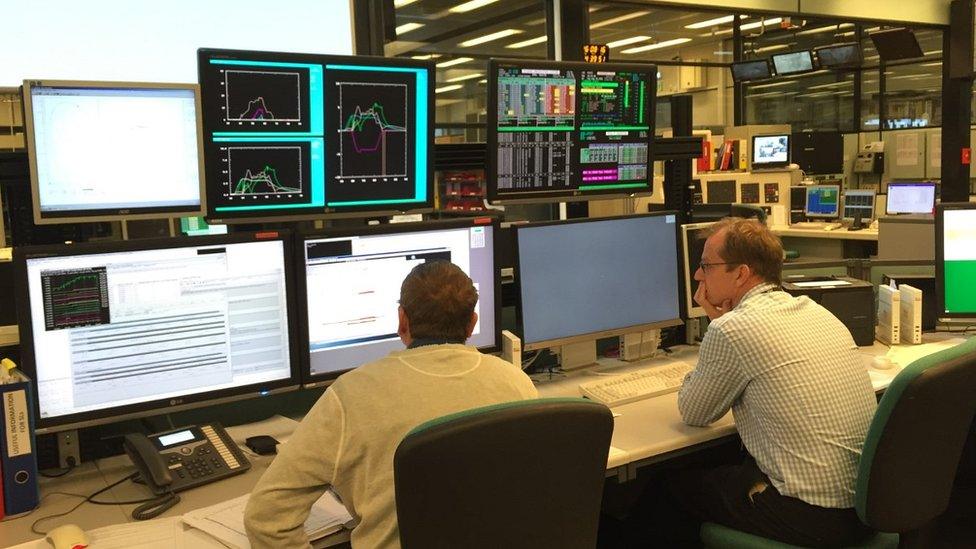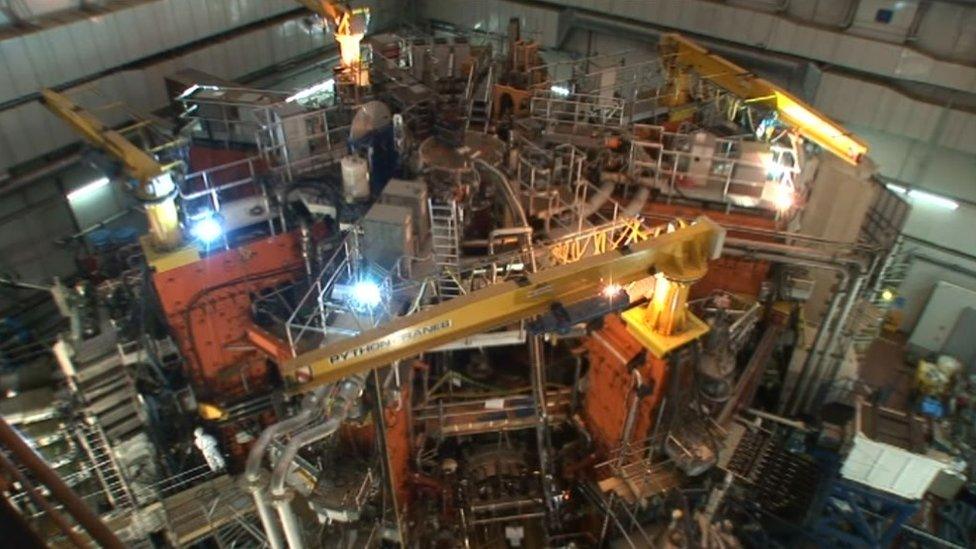UK nuclear fusion lab faces uncertain future
- Published

JET holds the record for the longest sustained nuclear fusion reaction
A question mark hangs over a world-leading laboratory that has pioneered research into fusion for nearly 40 years.
The Culham Centre for Fusion Energy near Oxford is largely funded by the EU and dozens of its scientists come from outside the UK.
Since the vote for Brexit, many at the centre have become "extremely nervous" amid uncertainty about future financing and freedom of movement.
Five researchers have already returned to continental Europe with others said to be considering their positions.
Fusion is the process that powers the Sun and a decades-long quest has attempted to replicate it here on Earth to provide a clean source of energy.
Since the 1970s, the Culham centre has hosted an experimental reactor known as the Joint European Torus (JET) that holds the global record for sustaining the longest burst of fusion.
It is the largest single research centre funded by the European Union in Britain.
Reactor dismantled?
Among many scenarios being discussed, the most extreme would see the reactor closed down and dismantled with its key components shared out among remaining members of the EU.
This comes just as preparations are under way for an important new run of fusion tests next year.
The JET facility works by creating a powerful magnetic field to contain the extremely high temperatures needed to force hydrogen atoms to fuse together and release energy.
The aim is to harness a potentially limitless source of power that would leave far less waste than the current generation of fission reactors and would at the same time generate electricity without carbon emissions.
Around 100 EU scientists from outside Britain are currently at the site and, according to Prof Steve Cowley, who was director of the facility until recently, many are "extremely nervous".
He told the BBC: "We've certainly lost a few people already - these are highly talented people at the very forefront of scientific discovery and we can't afford to lose them.
"This is the world's greatest fusion lab and if we don't find a way to make an agreement with Europe, this will all go - and our lead in this area will have been dissipated and I think that's an enormous shame."
"We'd be bonkers to close it down, and Europe would be bonkers to close it down, but these are uncertain times."

Brexit has cast a shadow of uncertainty over the JET facility
European funding runs at about 60m euros a year and the big unknown is whether that will continue - or at what level - once the UK leaves the EU.
Under the current arrangement, the UK contributes about 45m euros a year to Europe's fusion programme - and gets more money back with £45m a year to run the JET facility plus another £7m a year to support research.
A five-year contract is in place but it only runs until 2018 so concerns are focused on what happens after then.
Over the decades, hundreds of European scientists and engineers have spent time at Culham to work at JET and for many years there was even a European school for their children.
At lunchtime in the canteen recently, I met European members of staff who all said they were uncertain about their futures.
Stanislav Pamela, a theorectical physicist from France, told me: "I think it's quite worrying to know what's going to happen after the current contract has expired.
"It's a concern not only for the European people here but also for the English people because it puts the whole institute at risk."
Lidia Peron, an Italian physicist, said: "I'm a little bit worried about my family - what's going to happen to my children, if the work is going to continue."
Damien Karkinsky, a software engineer with dual UK-Bulgarian nationality, summed up the uncertainty view by saying "nobody knows what will happen".
"We don't want to move our jobs but if the EU decides to close the programme, we may have to find different places of employment."

Plans are being developed for the first fusion power station - but where will it be based?
The belief at the Culham centre is that having proved the basic science of fusion, the project is moving into a phase of engineering in which designs for an affordable commercial reactor are explored.
At the site, a smaller research reactor known as MAST is going through a £50m upgrade and, together with JET, it is meant to provide invaluable data on different designs and materials for a future reactor.
The information gained from this research is seen as crucial for shaping a massive international fusion effort, an experimental fusion reactor known as ITER, being built at Cadarache in southern France - many of whose design features are derived from work at Culham..
And, beyond ITER, plans are already being developed for the first fusion power station, a project called DEMO - British officials had high hopes that Culham would land the prestigious task of designing it. Now they are much less confident.
In the meantime, any future arrangements for Culham will depend on settling several fundamental questions.
Swiss option?
First, as a member of the EU, the UK is also a member of a related body called Euratom which co-ordinates nuclear research across the EU - will the UK automatically leave that too in March 2019?
Second, Europe's fusion funds are channelled via a collaborative organisation called EUROfusion. That also includes Switzerland - which is outside the EU - so would Britain try to negotiate a similar kind of membership and how long would that take?
Third, EUROfusion comes under the EU's Horizon 2020 research programme which non-EU countries can be part of, provided they contribute funds to it.
So will the UK government be willing to continue writing the cheques? And, if it is, will it run into similar problems to Switzerland which is a participant but may be denied funds because of its restrictions on freedom of movement?
Staff at Culham are running through a range of possible scenarios for their future from the worst-case of closure to one in which work continues.
Their hope is that the UK will agree to contribute to the Horizon 2020 programme post-Brexit and so enable funds to continue flowing to fusion research, and that work permits will be easily available for European scientists and engineers.
But clarity on the likely outcome is not easy to come by. The Department for Business, Energy and Industrial Strategy declined requests for an interview with science minister Jo Johnson.
A spokesperson said: "There has been no change in our participation in the EU's nuclear fusion research programme.
"The UK is a key contributor to joint EU research projects and we will be working closely with our EU partners to ensure international collaboration in this field continues."
The spokesperson referred me to earlier statements that the UK would underwrite any commitments under Horizon 2020 made before the UK leaves the EU.
EUROfusion declined to comment beyond guiding me to a statement posted the day after the referendum which said: "We will be working hard to continue the collaboration after 2018. If and how this is possible is impossible to say today."
Follow David on Twitter., external
Related topics
- Published16 August 2016
